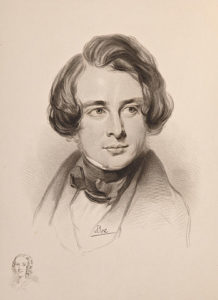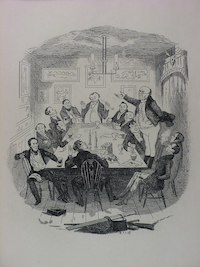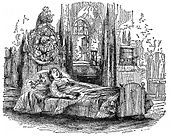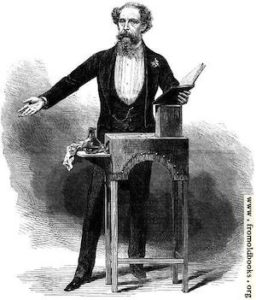
Charles Dickens (February 7, 1812-June 9, 1870) is often considered the finest English novelist of the 19th century. His enduring comic characters are part of the culture. He is known as well for exposing the wretchedness of the downtrodden, for his anger at their heartless oppression and for his contribution to the celebration of Christmas. An enormously successful author and performer of his own work, he was the conscience of Victorian England.
Although Dickens was baptized and reared in the Church of England and was a nominal Anglican for most of his life, he turned to Unitarianism in the 1840s as a Broad Church alternative. He associated with Unitarians until the end of his life. Early experience with Dissenters gave him a lifelong aversion to evangelical zeal, doctrinal disputation and sectarianism. Equally unsympathetic with High Church Anglicanism, he feared that the Oxford Movement might lead the English back to Roman Catholicism. Dickens, however, favored civil rights for Catholics and even once hoped his daughter would marry the Catholic Percy Fitzgerald, one of his literary proteges.
Born in Portsea (now Portsmouth), Charles was the second child of John and Elizabeth Barrow Dickens. John Dickens was an amiable but improvident naval pay clerk. Elizabeth Dickens, a keen observer, a talented mimic and a dramatic storyteller, was her son’s first teacher. Because of his parents’ precarious financial situation, Charles had a limited formal education, supplemented by his reading. In 1824-25 Charles, aged 12, spent a dreary, humiliating year working at Warren’s Blacking, a shoe polish factory, while his father was in debtors’ prison. The young Dickens felt an outcast and feared that his ambitions would be crushed. After John Dickens was released from prison, the Admiralty granted him a pension and he began working as a reporter for the British Press. From 1825-27 Charles was able to attend the Wellington House Academy, but since the British Press failed and his parents were evicted from their home, his education abruptly ended.
Charles began work as a solicitor’s clerk. In the evenings he taught himself shorthand, which led to work as a reporter, first at Doctors’ Commons law courts, 1829-31, then recording parliamentary debates for newspapers, 1832-34. In 1834 Dickens began placing humorous and satirical essays in magazines under the pseudonym “Boz.” Some of these were included in his first book, Sketches by Boz, published in 1836. His reporting provided him a wealth of experience. By 1858 critic Walter Bagehot would call him “a special correspondent for posterity.”
As a young reporter Dickens associated with other contributers to radical journals including William Johnson Fox, a Unitarian minister, and John Forster, a Unitarian who became a lifelong friend. Forster ultimately became Dickens’s literary executor and biographer.
While working for the Morning Chronicle, 1834-36, Dickens fell in love with and married Catherine Hogarth, daughter of the Chronicle‘s music critic. George Hogarth, friend of Robert Burns and Sir Walter Scott, encouraged Dickens’s writing and, as editor of the Evening Chronicle, published twenty of his “Sketches of London.” Charles and Catherine lived together for nearly two decades. They had ten children, one of whom died in infancy.

Dickens’s first novel, The Pickwick Papers, was planned as a series of articles to accompany a serialized set of engravings. The project became, instead, an episodic novel illustrated to Dickens’s specification. After a slow start, the Pickwick numbers became increasingly popular and by 1837 were a sensation. Pickwick catapulted Dickens to literary fame, and thereafter newspaper serialization became a standard way to introduce novels. A second novel, Oliver Twist, was serialized, 1837-39, in Bentley’s Miscellany, under Dickens’s editorship.

In 1837 Dicken’s beloved sister-in-law Mary died suddenly and his thoughts turned to immortality. One of the most celebrated scenes in The Old Curiosity Shop is the death of Little Nell. The schoolmaster tells the dying girl, “There is nothing . . . no nothing innocent and good, that dies and is forgotten. Let us hold to that faith or none. . . There is not an angel added to the Host of Heaven but does its blessed work in those that loved it here.” Dickens, however, later wrote, “I can’t preach to myself the schoolmaster’s consolation, though I try.”
After Mary Hogarth’s death Dickens temporarily suspended work on Pickwick. Yet, in spite of his sense of deep loss, he soon resumed his writing career. Nicholas Nickleby came out in installments during 1838-39. In 1840-41 he published a short-lived weekly, Master Humphrey’s Clock, in which The Old Curiosity Shop and Barnaby Rudge appeared.
In 1842 Dickens traveled to America. Later that year he drew upon letters written home to friends to compile a satirical travel narrative, American Notes. He also burlesqued Americans in the serialized novel, Martin Chuzzlewit, 1842-44, poking fun at the airy obscurity of Transcendentalism. He has an American bluestocking—possibly based on Margaret Fuller—say, “Mind and matter glide swift into the vortex of immensity. Howls the sublime, and softly sleeps the calm Ideal, in the whispering chambers of Imagination.”
He was kinder to Transcendentalists in American Notes. He found in Ralph Waldo Emerson’s essays “much that is dreamy and fanciful,” but also “much more that is true and manly, honest and bold.” He shared the Transcendentalist “hearty disgust of Cant” and concluded, “[I]f I were a Bostonian, I think I would be a Transcendentalist.”
Dickens had hoped to find in the United States progressive religious bodies, free from state control. Although disappointed with most American churches, he returned home full of enthusiasm for New England Unitarians in general, and William Ellery Channing in particular. He first attended Unitarian services at Essex Street chapel, London, and later took a pew at the Little Portland Street chapel. He liked the chapel’s minister, Edward Tagart, and they remained friends until the minister’s death sixteen years later. According to Dickens, Tagart had “that religion which has sympathy for men of every creed and ventures to pass judgment on none.” Dickens wrote to Unitarian Harvard professor Cornelius Felton, “I have carried into effect an old idea of mine and joined the Unitarians, who would do something for human improvement if they could; and practice charity and toleration.”
Dickens’s religious beliefs were those of most 19th century British Unitarians. In his will he urged his children to adopt a liberal, tolerant, and non-sectarian interpretation of Christianity, “the teaching of the New Testament in its broad spirit.” He recommended they “put no faith in any man’s narrow construction” of isolated passages. In The Life of Our Lord, written for his children and not published until 1934, Dickens summarized his faith as “to do good always.” He believed humanity, created in the image of the divine, retained a seed of good. He preached the gospel of the second chance. The world would be a better place if, with a change of heart, people were to treat others with kindness and generosity.
In 1843, while he was most active at Little Portland Street chapel, Dickens created the first and greatest of his Christmas books, A Christmas Carol. Around this time Christmas Day was again beginning to be celebrated and the holiday transformed. The story and its characters—Ebenezer Scrooge, Bob Crachit and Tiny Tim—defined the holiday’s meaning for the English-speaking world as the regenerative spirit of generosity, or what Dickens called his “Carol philosophy.” The heart of Dickens’s social criticism and his religious message is found in A Christmas Carol, his four other Christmas books, and his many seasonal stories.
For much of 1844-47 Dickens and his family lived and toured in Italy and France. During this period he wrote Pictures from Italy and his first mature novel, Dombey and Son. His next novel, the semi-autobiographical David Copperfield, 1849-50, was his favorite and his masterpiece.
Meanwhile, early in 1846 Dickens had briefly returned to journalism as the first editor of the Daily News, later London’s leading Liberal paper. His major journalistic venture was as co-owner and editor of the weekly magazine, Household Words, 1850-59. It published pieces by Dickens and others, including Elizabeth Gaskell, Harriet Martineau, Elizabeth Barrett Browning, Wilkie Collins and Edward Bulwer-Lytton. The magazine did not serialize novels until 1854 when, pressed by a decline in profits, Dickens began running his industrial novel, Hard Times. He then also published Gaskell’s novel, North and South. Household Words carried articles about kindergartens, literacy, sanitation, prisons and the right of workers to organize. Though aiming primarily at middle-class readers, Dickens made its mission “raising up of those that are down” and teaching “the hardest workers. . .that their lot is not necessarily a moody, brutal fact, excluded from the sympathies and graces of imagination.”
Dickens’s work for charitable organizations foreshadowed the Social Gospel. He was critical of any religion that did not seek to relieve poverty. Moreover, he had no patience with those who raised money for foreign evangelism when there was so much suffering at home. He strongly supported the Unitarian health and housing reformer, Southwood Smith. The reform work with which Dickens was most personally involved was Urania Cottage, a home for fallen and other homeless women, funded by his friend, the philanthropist Angela Burdett Coutts. Coutts favored strict treatment of the inmates, but Dickens insisted they be “tempted to virtue” in an environment more like a household than a prison. He had earlier convinced Coutts to fund the Field Lane Ragged School, which provided evening classes for the poor. Dickens’s friend Countess Russell was among other Unitarians who shared his interest in the Ragged School experiment.
Beginning in 1842 Dickens organized and acted in a series of amateur theatrical productions. In 1851 he helped organize the Guild of Literature and Art to encourage and support struggling authors and artists, which he endowed with the proceeds from his plays. In 1857 the troupe gave a command performance of his friend Wilkie Collins’s The Frozen Deep for Queen Victoria and Prince Albert.
Long dissatisfied in his marriage, Dickens fell in love with a young actress, Ellen Ternan, during the run of Collins’s play. Charles and Catherine separated the following year. Members of the Hogarth family spread rumors about his adultery. Anxious to end the scandal, Dickens printed a protest of innocence on the front page of Household Words. Disagreement with his partners, who refused to reprint his statement in Punch, led to the dissolution of Household Words.
Dickens loved children. He portrayed them with sympathy and understanding. For his own adored sons and daughters he devised elaborate entertainments. They continued to idolize him, though his marriage was failing. Their mutual affection cooled as the children became adolescents, and Dickens was disappointed in them as adults.
With the development of Broad Church Anglicanism Dickens returned to the Church of England. After 1856 he lived in a country house, Gad’s Hill Place, where he hoped to renew his childhood experience of an idyllic village church which he described in his 1860 essay, “City of London Churches.” At the same time, however, he accepted Charles Darwin’s theory of evolution, was interested in higher biblical criticism and was disgusted by church quarrels and the Protestant establishment’s attempts to control freedom of thought. He attended the parish church irregularly, and when a dull curate arrived, he stopped.
In the 1850s Dickens wrote two long serialized novels: Bleak House and Little Dorrit. In Bleak House he indicted the Court of Chancery, and the legal system in general, for absolute ineffectiveness. In Little Dorrit he examined the British prison system, especially debtors’ prisons, and attacked the Victorian class system. In the weekly, All the Year Round, which Dickens supervised, 1859-70, two of his best-known novels appeared: A Tale of Two Cities and Great Expectations. He dedicated A Tale of Two Cities to his friend, Lord John Russell, champion of political reform and religious emancipation. The novels of Dickens’s last decade were Our Mutual Friend and the unfinished The Mystery of Edwin Drood.
In 1863 a Jewish acquaintance, Eliza Davis, wrote Dickens a letter complaining of the Oliver Twist character, Fagin, as “a great wrong” to the Jewish people. He replied that he had not meant any disrespect towards Judaism, but only meant to give his character a nationality. He made amends in Our Mutual Friend when he turned the stereotype upside down. The sympathetically drawn Mr. Riah is forced to front for a Christian moneylender, and a generous community of Jews shelters the heroine, Lizzie Hexam. Riah reflects, “[People] take the worst of us as samples of the best . . . and they say ‘All Jews are alike.'” Mrs. Davis gave Dickens a Hebrew and English Bible inscribed, “Presented to Charles Dickens, in grateful and admiring recognition of his having exercised the noblest quality men can possess-that of atoning for an injury as soon as conscious of having inflicted it.”
During the last two decades of his life Dickens gave public readings from his works, using his acting skills to bring his characters and scenes to life on the stage. He began in 1853 with occasional

public readings of A Christmas Carol to benefit charities providing adult education. Needing cash after the breakup of his marriage, he began paid performances of Christmas stories and scenes from his novels. His readings were more profitable than new books. He toured Great Britain, Ireland and America.
On the second tour of the United States, 1867-68, Dickens renewed his ties with American Unitarians. Among these were his American publisher James Fields of Ticknor and Fields, the abolitionist Senator Charles Sumner, poet Oliver Wendell Holmes, and Ralph Waldo Emerson. His longtime friend, Henry Wadsworth Longfellow, later paid him a return visit at Gad’s Hill.
Dickens had begun to age noticeably after he and Ellen Ternan were in in the 1865 Staplehurst railway accident. In March, 1870, the ailing Dickens was received by Queen Victoria, who later said, “He had a large, loving mind and the strongest sympathy with the poorer classes.” Dickens last reading was only a few days later. Following this performance he said, “From these garish lights I vanish now forevermore.” Within three months he was dead and laid to rest in the Poet’s Corner of Westminster Abbey, near the memorials to Milton, Spenser, Dryden, Chaucer and Shakespeare.
Dickens’s works have been continuously popular since their publication. The Pickwick Papers, Oliver Twist, A Christmas Carol and David Copperfield have been general favorites. Radicals and socialists, including Karl Marx, Friedrich Engels and George Bernard Shaw, honored him for his astute analysis of social problems. George Orwell observed that although “Dickens attacked English institutions with a ferocity that has never since been approached . . . the very people he attacked have swallowed him so completely that he has become a national institution himself.”
During Dickens’s life his reception by literary critics was mixed. Some compared him to Cervantes and Shakespeare; others could not regard his serialized novels as serious literature. At the turn of the twentieth century Virginia Woolf and E. M. Forster decried his works as mawkish, and they were excluded from academic curricula. On the other hand, G. K. Chesterton called Dickens “the last great poet.” In 1940-41 three essays, by Edmund Wilson, George Orwell and Humphry House, marked the beginning of a critical reassessment of Dickens. Wilson’s “Dickens: The Two Scrooges” (1940) noted in Dickens’s life and work such serious concerns as strained relationships between sons and fathers, trauma in early childhood experience, hallucinations, obsessions and divided personalities. Contemporary taste favors Dickens’s later, darker novels. Critical consensus now places him second only to Shakespeare among English writers.
Sources
Dickens manuscripts and letters are in the Forster Collection, Victoria and Albert Museum, London; Dickens House, London; the British Museum; the Berg Collection, New York Public Library; Pierpont Morgan Library, New York City; the Benoliel Collection, Free Library of Philadelphia; the Henry E. Huntington Library and Art Gallery, San Marino, California; the Harry Ransom Humanities Research Center, University of Texas Libraries; the Beineke Rare Book and Manuscript Library, Yale University Library; the Parrish Collection, Princeton University Library, Princeton, New Jersey; and the Sadlier Collection, University of California at Los Angeles. The British Academy Pilgrim Edition, The Letters of Charles Dickens (1965- ), edited by Madeleine House, Graham Storey, Kathleen Tillotson et al., has reached its 11th volume, taking Dickens’s letters from 1820 to 1867. Other primary documents have been published as Kenneth Fielding, ed., The Speeches of Charles Dickens (1960); Philip Collins, ed., Charles Dickens: The Public Readings (1975); Philip Collins, ed., Charles Dickens: The Critical Heritage (1971); and Philip Collins, ed., Dickens (1981), which contains interviews with people who knew Dickens.
In addition to the works mentioned in the above article Dickens wrote many Christmas stories (in Household Words, 1850-58, and All the Year Round, 1859-67) and four Christmas books: The Chimes (1844); The Cricket on the Hearth (1845); The Battle of Life (1846); and The Haunted Man (1848). His works also include A Child’s History of England (1852-54); Reprinted Pieces (1858; contributed to Household Words, 1850-56); The Uncommercial Traveller (1861, amplified 1868, 1875; contributed to All the Year Round, 1860-69); Plays and Poems, ed. by R.H. Shepherd (1885); Miscellaneous Papers, ed. by B.W. Matz (1908; the most substantial posthumous collection, mainly essays contributed to Household Words, 1850-59); and 16 further items, in a volume retitled Collected Papers, in The Nonesuch Dickens (1937). In addition there is Harry Stone, ed., Uncollected Writings of Charles Dickens: Household Words 1850-1859 (1969). Dickens did parliamentary reporting for the True Sun, 1832; the Mirror of Parliament, 1832-33; and the Morning Chronicle, 1834-6. The journalism collected in Sketches by Boz, Reprinted Pieces, and The Uncommercial Traveller represents less than half of what Dickens wrote for magazine publication. The pamphlet, Sunday under three Heads (1836), written by Dickens under the pseudonym “Timothy Sparks,” expressed his opposition to the Sunday Observances Bill.
Forster’s The Life of Charles Dickens, which contained many primary documents including autobiographical fragments by Dickens, appeared between 1872 and 1874. Much information about Dickens’s private life was kept secret until the 1930s. The first major modern biography is Edgar Johnson, Charles Dickens: His Tragedy and Triumph, 2 vol. (1952, reprinted 1965). More recent biographies include Fred Kaplan, Dickens: A Biography (1988) and Peter Ackroyd, Dickens (1990). Among the historically important studies of Dickens are G.K. Chesterton, Charles Dickens, A Critical Study (1906); George Orwell, “Charles Dickens,” Inside the Whale (1940); and Edmund Wilson, “Dickens: The Two Scrooges,” The Wound and the Bow (1941). Important for the study of Dickens’s religious affiliations, beliefs, and their bearing on social issues are J.M. Connell, “Dickens Unitarian Minister, Edward Tagart,” Transactions of the Unitarian Historical Society (October, 1944); R.V. Holt, Unitarian Contribution to Social Progress in England (1952); Dennis Walder, Dickens and Religion (1981); and Joseph Gold, Charles Dickens: Radical Moralist (1972). The entries in Paul Schlicke, ed., Oxford Reader’s Companion to Dickens (1999) shed light on various aspects of Dickens’s background, life and work.
Article by Wesley Hromatko
Posted December 23, 2001